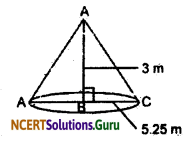NCERT Solutions for Class 9 Maths Chapter 14 Statistics Ex 14.3
These NCERT Solutions for Class 9 Maths Chapter 14 Statistics Ex 14.3 Questions and Answers are prepared by our highly skilled subject experts.
NCERT Solutions for Class 9 Maths Chapter 14 Statistics Exercise 14.3
Question 1.
A survey conducted by an organisation for the cause of illness and death among the woman between the age 15 – 44 (in years) worldwide, found the following figures (in %)

(i) Represent the information given above graphically.
(ii) Which condition is the major cause of woman’s ill health and death worldwide?
(iii) Try to find out, with the help of your teacher, any two factors which play a major role in the cause in (ii) above is the major cause.
Solution:
(i) The information given above represent graphically as:

(ii) Reproductive health conditions are the major cause of women’s ill health and death worldwide.
(iii) Two factors which play a major role in the cause of women’s ill health and death worldwide are reproductive health condition and neuropsychiatric condition.
![]()
Question 2.
The following data on the number of girls (to the nearest ten) per thousand boys in different sections of Indian society are given below:

(i) Represent the information above by a bar graph.
(ii) In the classroom discuss what conclusions can be arrived at from the graph.
Solution:
(i)

(ii) Two conclusions arrive from the graph are:
(a) Number of girls per thousand boys and most in schedule tribe and least in urban.
(b) The average number of girls per thousand boys is less than 950.
Question 3.
Given below are the seats won by different political parties in the polling outcome of state assembly elections.

(i) Draw a bar graph to represent the polling results.
(ii) Which political party won the maximum number of seats?
Solution:
(i)

(ii) Political party ‘A’ won the maximum number of seats.
![]()
Question 4.
The length of 40 leaves of a plant is measured correct to one millimeter, and the obtained data is represented in the following table:

(i) Draw a histogram to represent the given data.
(ii) Is there any other suitable graphical representation for the same data?
(iii) Is it correct to conclude that the maximum number of leaves is 153 mm long? Why?
Solution:
(i) First we make the continuous class interval frequency distribution table.


(ii) Yes, we can draw frequency polygon to represent the same data.
(iii) Class interval 145 – 153 of lengths are the maximum number of leaves. But it is not concluded that the maximum number of leaves is 153 mm long.
Question 5.
The following table gives the lifetimes of 400 neon lamps.

(i) Represent the given information with the help of a histogram.
(ii) How many lamps have a lifetime of more than 700 hours?
Solution:
(i)

(ii) 184 lamps have a lifetime of more than 700 hours.
![]()
Question 6.
The following table gives the distribution of students of two sections according to the marks obtained by them:

Represent the marks of the students of both the sections on the same graph by two frequency polygons. The two polygons compare the performance of the two sections.
Solution:

Question 7.
The runs scored by two teams A and B on the first 60 balls in a cricket match are given below:

Represent the data of both the teams on the same graph by frequency polygons.
[Hint: First make the class intervals continuous]
Solution:
First, we make the continuous class interval frequency distribution table.


Question 8.
A random survey of the number of children of various age group playing in a park was found as follows:

Draw a histogram to represent the data bove.
Solution:
To draw a histogram to represent the data first we make data in which we clear the length of the rectangle.


![]()
Question 9.
100 surnames were randomly picked up from a local telephone directory and a frequency distribution of the number of letters in the English alphabet in the surnames was found as follows:

(i) Draw a histogram to depict the given information.
(ii) Write the class interval in which the maximum number of surnames lie.
Solution:
(i) Draw a histogram to represent the first we make a data in which we clear the length of the rectangle.


(ii) The class interval in which the maximum number of surnames lie in 6 – 8 letters.
NCERT Solutions for Class 9 Maths Chapter 14 Statistics Ex 14.3 Read More »













































